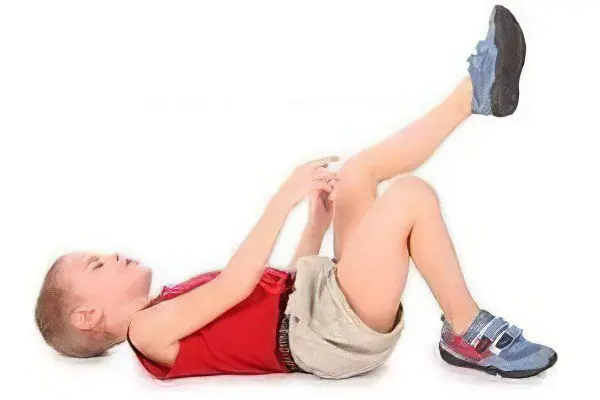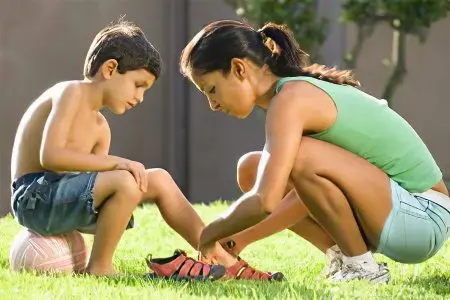Contents
It is sad to realize that such a terrible disease as arthritis does not bypass even the smallest inhabitants of our planet. But harsh statistics say that every thousandth child under the age of 3 years becomes a victim of this disease. The peak incidence is considered to be between one and three years of age, but this is purely individual. What are the symptoms and treatment of arthritis in children, you will learn from our material below.
Symptoms of arthritis in children
If the child is very small and still unable to clearly state his complaints, then it can be quite difficult to determine if he has arthritis.
Parents should be attentive to the behavior of their child. You should be on the lookout for the following signs:
Causeless whims of a child with a possible refusal to eat;
Lameness while walking or playing (the baby tries to walk less and does not allow touching the sore spot);
Complaints of pain without any objective reason (there was neither a fall nor a bruise);
Swelling and redness in the joint area;
Difficulty lifting arms or legs
Changes in the child’s gait.
If at least one of the above symptoms has been detected, you should immediately seek the advice of a medical specialist.
The general symptoms of arthritis in children can also include the following series of signs:
Increase in body temperature;
The appearance of itchy spots and rashes on the skin around the diseased joint;
An increase in regional lymph nodes located near the focus of inflammation.
Causes of arthritis in children

Proper treatment of arthritis in children is possible only after establishing the true cause of its occurrence.
Causes of childhood arthritis include:
Infectious diseases;
hereditary predisposition;
Decreased immunity;
Violation of metabolic processes in the body;
Traumatic injuries;
Diseases of the nervous system;
Impact of low temperatures.
Diagnosing arthritis in children is often difficult. For example, a child has been ill with an infectious disease, to which the parents did not attach much importance, and inflammation of the joints was a complication.
Types of arthritis in children

Among all the varieties of childhood arthritis, the following main forms can be distinguished:
Reactive arthritis. This is an aseptic inflammatory disease that mainly affects the joints of the lower extremities. The cause of the occurrence is a previously transferred bacterial infection. Reactive forms of arthritis include urogenital and post-enterocolitis arthritis. For example, the urogenital form occurs on the basis of an existing infectious process in the organs of the genitourinary system;
Infectious form of arthritis. Bacterial, viral and fungal infections contribute to the occurrence of this form of the disease. The place of localization of pathogens is directly the joint cavity, into which they enter with the flow of blood or lymph. The risk of infectious arthritis increases after trauma to the joint. Infectious arthritis is most common in children under three;
Juvenile form of rheumatoid arthritis. The etiology of this disease is still not fully understood. It is believed that the determining factor is burdened heredity. Children under the age of 16 are at risk for juvenile arthritis. Juvenile arthritis primarily affects large joints, causing them to enlarge and deform. The danger of the disease lies in its rapid and steady progression, and in severe cases, even damage to internal organs is possible. The juvenile form of rheumatoid arthritis can occur with inflammation of only the articular apparatus, and may involve the lungs or heart in the process;
Bechterew’s disease. Most often, this disease debuts at an early age and is manifested by a chronic inflammatory process in the peripheral joints and spinal column;
Rheumatic form of arthritis. It is a pathognomonic manifestation of childhood rheumatism. Children under the age of 16 are at risk for morbidity. For diseases such as chorea, erythema annulare, and rheumatism, the common feature is their infectious origin. Most often, the cause of their occurrence is a streptococcal infection (tonsillitis, tonsillitis, pharyngitis).
Treatment of arthritis in children
Treatment of arthritis in children can take a long time and must be approached in a comprehensive manner. Along with drug therapy, special therapeutic massage and physiotherapy are used. If the disease is in the acute phase, outpatient treatment will be ineffective. The child must be in a hospital, where they can put a special splint on him to immobilize the diseased joint.
Operative intervention with arthritis in childhood, it is indicated only in the presence of a serious deformity of the joints, which is corrected with the help of prosthetics.
Drug therapy consists of two consecutive stages:
The use of non-steroidal anti-inflammatory drugs to relieve the painful symptoms of the disease;
Taking drugs that suppress the immune system, if we are talking about rheumatoid arthritis (immunosuppressants);
Carrying out detoxification therapy;
Strengthening the drainage function of the body.
The use of the first group of drugs helps to relieve severe pain, reduce the inflammatory response and improve joint mobility.
For the symptomatic treatment of arthritis in children, the following drugs are used:
Acetylsalicylic acid. It is a mandatory attribute of conservative drug therapy for arthritis. The advantages of this drug include its effectiveness, but it is categorically contraindicated for existing blood clotting disorders;
Diclofenac.Currently, experts have come to the conclusion that against the background of the use of diclofenac by children, erosive changes in the upper parts of the digestive tract may occur. In addition, it is categorically contraindicated in children under 6 years of age;
Indomethacin proved to be an excellent anti-inflammatory and anti-edematous agent. Experts have designated it as the drug of choice in the treatment of arthritis in children;
Naproxen – another anti-inflammatory drug. It is indicated for the treatment of rheumatoid and juvenile arthritis in children. Its only drawback is the age restrictions. Naproxen is indicated only for children over 10 years of age.
Detoxification therapy is aimed at activating local and general immunity, harmonizing metabolic processes and normalizing blood circulation in the articular apparatus.
Stimulation of the drainage function is the key to the complete removal of toxins from the focus of the disease and stimulation of the nutrition of the joint area.
The specifics of the treatment of reactive arthritis in children is the following sequential actions:
Removal of severe pain syndrome;
Neutralization of the infectious focus.
Elimination of the consequences of the disease.
Non-steroidal anti-inflammatory drugs (NSAIDs) described above are used to relieve pain. If a child is worried about excruciating pain that cannot be relieved by NSAIDs, one has to resort to intra-articular injections using hormonal anti-inflammatory drugs from the glucocorticoid group (methylprednisolone). Before prescribing corticosteroids, it is necessary to be sure that there are no pathogens in the intra-articular fluid.
To eliminate the infectious focus, in the practice of treating children’s arthritis, doctors widely use drugs from the group of macrolides. Due to their gentle effect, it is possible to avoid serious side effects. The drugs of choice are clarithromycin, roxithromycin, and josamycin.
If we talk about the intestinal etiology of reactive arthritis, then, by and large, the fight against intestinal infection will be useless due to its absence at the time of diagnosis. The thing is that when arthritis develops, there is no infectious focus in the intestine. Antibacterial therapy with aminoglycosides should be carried out only before potentially possible immunosuppressive therapy.
If the disease has become chronic, there is a need for pathogenetic treatment. The main components of such therapy are immunomodulatory drugs that ensure the stable functioning of the immune system. These drugs include taquitin, licopid and polyoxidonium.
For rheumatoid arthritis no treatment will bring the expected result if immunosuppressants are not used. Only these funds can stop the process of destruction of the affected joints of the child. Drugs such as cyclosporine, mercaptopurine and leflunomide are widely used.
Treatment of juvenile arthritis It is carried out using anti-inflammatory drugs in combination with a special diet. Calcium-rich foods should be present in the daily diet of the child. In order for the treatment to take place with maximum benefit, it is necessary to properly organize the regime of physical activity and rest.
Nontraditional methods of treatment

Non-traditional methods of treating arthritis in children can serve as an excellent addition to conservative therapy.
One of the universal and very effective means is white, blue and pink clay. It has a pronounced anti-edematous and anti-inflammatory effect. Clay is suitable for external use in the treatment of arthritis in children older than 3 years. It must be used in the form of a compress, which is applied to the diseased joint, covered with cellophane and wrapped in a woolen cloth.
For the treatment of children over 6 years old, you can use a decoction of thistle herb in the form of compresses and lotions. It is a good adjuvant in the treatment of rheumatoid arthritis. To prepare a decoction, you need to take 1 tablespoon of thistle herb and pour a glass of boiling water. Boil the broth for half an hour, then cool and strain. A small piece of gauze is moistened in the resulting decoction and applied to the diseased joint, the compress should be covered with polyethylene and woolen cloth from above.
For older children, going to the bathhouse can be a good auxiliary remedy. Brief exposure to heat on the joints will help relieve pain. However, the bath is unacceptable in the acute period of the disease.
Recovery Predictions
Unfortunately, arthritis is one of the diseases that accompany a person throughout his life. Provided that the correct treatment is timely prescribed, the child will be able to lead a full life without remembering his illness. Of course, physical activity will have to be limited to the level of daily exercise, but professional sports for these children are strictly prohibited.
So that frequent recurrences of arthritis do not bring the child to disability, you should immediately seek help from a medical specialist immediately after the first signs of the disease appear.
A couple of tips for parents
To alleviate the course of arthritis and not provoke new relapses, parents should follow the following rules:
Exclude from the child’s diet fatty foods and foods that contribute to the development of an allergic reaction;
The child should always be dressed for the weather to avoid hypothermia;
In the midst of an epidemic of viral disease, parents should take care to carry out adequate preventive measures;
If a child has a cold, it is necessary to undergo a full course of treatment using physiotherapy methods.
Carrying out any type of therapy and prescribing drugs should be carried out exclusively by a doctor. Only a specialist can make a selection of treatment according to the individual characteristics of the child’s body.









